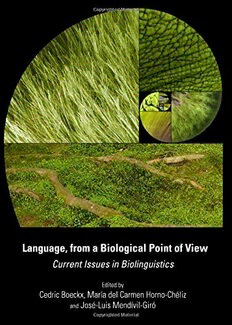
Language, from a Biological Point of View: Current Issues in Biolinguistics PDF
Preview Language, from a Biological Point of View: Current Issues in Biolinguistics
Language, from a Biological Point of View Language, from a Biological Point of View: Current Issues in Biolinguistics Edited by Cedric Boeckx, María del Carmen Horno-Chéliz and José-Luis Mendívil-Giró Language, from a Biological Point of View: Current Issues in Biolinguistics, Edited by Cedric Boeckx, María del Carmen Horno-Chéliz and José-Luis Mendívil-Giró This book first published 2012 Cambridge Scholars Publishing 12 Back Chapman Street, Newcastle upon Tyne, NE6 2XX, UK British Library Cataloguing in Publication Data A catalogue record for this book is available from the British Library Copyright © 2012 by Cedric Boeckx, María del Carmen Horno-Chéliz and José-Luis Mendívil-Giró and contributors All rights for this book reserved. No part of this book may be reproduced, stored in a retrieval system, or transmitted, in any form or by any means, electronic, mechanical, photocopying, recording or otherwise, without the prior permission of the copyright owner. ISBN (10): 1-4438-3781-4, ISBN (13): 978-1-4438-3781-1 TABLE OF CONTENTS Acknowledgments.....................................................................................vii Introduction.................................................................................................1 Integrating Linguistics and Biology C. Boeckx, M.C. Horno-Chéliz and J.L. Mendívil-Giró Part I Language and Cognition Introduction to Part I..................................................................................14 For an Approach to Language with Biocognitive Import: The Dismissal of Specificity and Other Issues Joana Rosselló and Txuss Martín Chapter One...............................................................................................23 The I-language Mosaic Cedric Boeckx Chapter Two..............................................................................................52 Theoretical Linguistics meets Development: Explaining FL from an Epigeneticist Point of View Víctor M. Longa and Guillermo Lorenzo Chapter Three............................................................................................85 The Myth of Language Diversity José-Luis Mendívil-Giró Part II Language and the Brain Introduction to Part II..............................................................................136 Looking for Language into the Brain María del Carmen Horno-Chéliz vi Table of Contents Chapter Four............................................................................................143 The Role of Aphasic Disorders in the Study of the Brain–language Relationship Fernando Cuetos Chapter Five............................................................................................165 Word Processing Cristina Baus and Manuel Carreiras Chapter Six..............................................................................................184 More than One Language in the Brain Itziar Laka Part III Language and the Species Introduction to Part III.............................................................................208 Up the Cudgels for Lenneberg! Sergio Balari Chapter Seven..........................................................................................215 The “Language Genes” Antonio Benítez-Burraco Chapter Eight...........................................................................................263 The Evolution of the Faculty of Language Guillermo Lorenzo Chapter Nine............................................................................................290 Animal Minds and the Roots of Human Language Bridget Samuels Bibliography............................................................................................314 Contributors.............................................................................................384 Index........................................................................................................388 ACKNOWLEDGMENTS This book originated as a series of lectures organized in 2009 by M.C. Horno-Chéliz and J.L. Mendívil-Giró, as part of the summer course offerings of the University of Zaragoza in its summer headquarters in Jaca. The event, Language, brain and genes: lectures in Biolinguistics, brought together several authors of this volume (Benítez-Burraco, Boeckx, Cuetos, Laka, Lorenzo), as well as others, such as Andrea Moro, who unfortunately could not contribute to this volume. The success of the event among students led us to start thinking of a volume covering the topics of the lectures, as well as addressing issues for which the intensive, 3-day summer course had not left any room. The editors of the present volume invited Bridget Samuels to turn her poster presentation in Jaca into a chapter, and welcomed V. Longa, C. Baus, and M. Carreiras to the project. The editors also asked S. Balari, T. Martín and J. Rosselló, founding members of the Biolinguistics Group in Barcelona, to write introductions for two of the parts of the book. The editors would like to thank all the authors for their collaboration, and their patience during the editing process. Completion of this project was made possible by funds from the following sources, which are gratefully acknowledged: Marie Curie International Reintegration Grant from the European Union (PIRG-GA- 2009-256413; recipient: CB), research funds from the Fundació Bosch i Gimpera, from the Gobierno de Aragón to the Sylex group (Universidad de Zaragoza), as well as grants from the Spanish Mininistry of Science and Innovation (FFI-2010-20634; PI: Boeckx), and from the Generalitat de Catalunya. INTRODUCTION INTEGRATING LINGUISTICS AND BIOLOGY CEDRIC BOECKX, MARÍA DEL CARMEN HORNO-CHÉLIZ AND JOSÉ-LUIS MENDÍVIL-GIRÓ The present volume offers a collection of essays covering a broad range of areas where currently a rapprochement between linguistics and biology is actively being sought. Following a certain tradition we call this attempt at a synthesis biolinguistics. The goal of this introductory chapter is to examine, all too briefly, the nature of biolinguistics, a term that is encountered with increased frequency in linguistic, and more generally, cognitive science circles these days, and to offer an overview of the chapters to come. The term biolinguistics is not new (its first appearance dates back to 1950), but recently, it has figured prominently in the titles of articles, books, book series, journals, courses, conferences, symposia, grant proposals, research interests on CVs, and research groups. In the following pages, we want to focus on two issues: (i) why this resurgent interest in biolinguistics? and (ii) the opportunities and challenges that this implies for linguists, which are treated in more detail in the chapters that follow. 1. Why Now?: Factors that led to the return of biolinguistic concerns One can rarely, if ever, predict the course of events, in science or elsewhere, but with the benefit of hindsight, one can recognize several factors that contributed to the renaissance of biolinguistics. We say renaissance because there was a brief period during the 1970s where the term enjoyed a certain popularity. As mentioned above, the term
